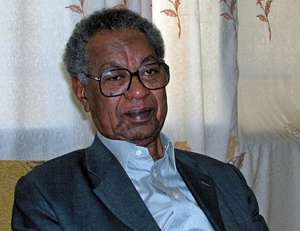African Library
Reviewed by Annie Gagiano
Considered a classic of the African Arabian (and, in its English translation, even Europhone) canon, this complex work manages to be at once subtle and shocking. It was first published (in Beirut, rather than in the author’s native Sudan) in 1967, in Arabic, and two years later in the English translation. The novel has a rather shadowy narrator figure, who could (some critics argue) be considered the actual central figure of the text, but he is greatly overshadowed by the man who (in the style of Coleridge’s Ancient Mariner) imposes his own, strange story on the narrator and makes of him a sort of heir — this flamboyant character is called Mustafa Sa’eed (hereafter MS).
Both the narrator and the abovementioned MS are Sudanese who go to Britain for advanced study; MS in economics and the narrator in English literature. They meet in the small village along the Nile which is the narrator’s ‘home town’, where his beloved and ancient grandfather still lives. The villagers “were surprised when I told them that Europeans were, with minor differences, exactly like them” (3), the narrator tells us. At this stage MS is to all intents and purposes an ordinary farmer, with a ‘local’ wife and two young sons. When MS (inadvertently, or deliberately?) quotes an English poem on a drunken evening, the narrator becomes suspicious. Most of the rest of the novel concerns his recollections of the exceedingly strange story that MS tells him — a story which haunts and oppresses, yet also challenges him in terms of defining his own value system in ‘postcolonial’ Sudanese society — in the context of “the new rulers of Africa, smooth of face, lupine of mouth, ... in suits of fine mohair and expensive silk” (118). The narrator works as a bureaucrat in the Education ministry in Khartoum, but regularly visits his grandfather’s village, where he finds himself slowly falling in love with the widow of MS (who has in the meantime apparently been drowned in the flooded Nile).
The life story MS had narrated began with the account of his (British, colonial) schooling, which had led him to the discovery of his own mind, “like a sharp knife, cutting with cold effectiveness” (22). So brilliant is he that from Khartoum he is sent to Cairo and then to London for advanced study — here he is nicknamed “the black Englishman” (54). In British society he becomes a sexual predator, setting up as his lair a room seductively decorated with ersatz ‘African’ paraphernalia. Englishwomen of a wide range of classes and ages easily succumb to and are destroyed by him. Three of these women are driven to suicide; while he eventually murders the most provocative of them, who had humiliated and taunted him before — and also during — their stormy marriage. This act (a sort of sex-murder) is in his own eyes, however, the grand consummation of his life:
‘The sensation that ... I have bedded the goddess of Death and gazed out upon Hell from the aperture of her eyes — it’s a feeling no man can imagine. The taste of that night stays on in my mouth, preventing me from savouring anything else.’ (153)
Elsewhere MS says of this relationship that he “was the invader who had come from the South, and this was the icy battlefield from which [he] would not make a safe return” (160). He kills Jean Morris (who invites this death) by pushing a knife into her chest between her breasts, and is jailed for seven years for the murder. This secret history persistently troubles MS’s confidant, the narrator. Before MS (an excellent swimmer, we’re told) disappears — apparently drowned — he had written a letter to be given to the narrator (himself married, with a daughter), virtually ‘bequeathing’ him his two young sons. In the letter MS states that he is irresistibly drawn “towards faraway parts” (67). MS’s second, Sudanese wife (Hosna Bint Mahmoud) is, however, left prey to the sexual fancies of the much-married, 70-year-old Wad Rayes who (with the complicity of the village patriarchy) forces her into marriage while the narrator is away in Khartoum. Hosna resists all her second husband’s advances. When he eventually attempts to rape her, she stabs him to death and then kills herself. Everyone in the village except the narrator is outraged that a woman (and a wife!) could have done this — shattering his idealised image of village society. Yet he is equally outraged at MS and construes Hosna as his (MS’s) final victim.
On his return to the village, the narrator at last enters a secret room that MS had built next to his home — a replica of a British gentleman’s drawing room! Pride of place has been given to MS’s painting of his ‘white’ wife, Jean Morris. The room also contains a book, purportedly the “Life Story” of MS, dedicated “To those who see with one eye ... and see things as ... either Eastern or Western” (150-151). The book is completely blank. Filled with rage at everything that has happened, and also at himself, the narrator plunges into the Nile. A “numbness” strikes him, “half-way between north and south”, leaving him “unable to return” (167). From the water, he sees birds flying “northwards”, perhaps in a “migration”, and he “wak[es] from the nightmare” (168).He decides that there are things worth living for, and he shouts for help (169). This brief account cannot accommodate the complicated structure, subtle allusiveness and richly metaphoric style of this difficult text, but may give some indication of its ironic (or sardonic) perspective and of its deep and lasting relevance to the political and cultural predicament of many Africans. Its demonstration of the harsh parallels between colonial racism and local sexism confirms that this text is, as Salih himself has stated, “a plea for toleration” at all levels. It is an unforgettable work.




